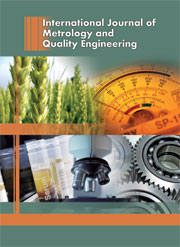Crossref Citations
This article has been cited by the following publications. This list is generated based on data provided by
Crossref.
Lalehpour, Amirali
Berry, Cody
and
Barari, Ahmad
2017.
Adaptive data reduction with neighbourhood search approach in coordinate measurement of planar surfaces.
Journal of Manufacturing Systems,
Vol. 45,
Issue. ,
p.
28.
Mian, Syed Hammad
and
Al-Ahmari, Abdulrahman M
2017.
Application of the sampling strategies in the inspection process.
Proceedings of the Institution of Mechanical Engineers, Part B: Journal of Engineering Manufacture,
Vol. 231,
Issue. 4,
p.
565.
Berry, Cody
and
Barari, Ahmad
2019.
Cyber-Physical System Utilizing Work-Piece Memory in Digital Manufacturing.
IFAC-PapersOnLine,
Vol. 52,
Issue. 10,
p.
201.
Mian, Syed Hammad
Al-Ahmari, Abdulrahman
Alkhalefah, Hisham
and
Gil-Lafuente, Anna M.
2019.
Analysis and Realization of Sampling Strategy in Coordinate Metrology.
Mathematical Problems in Engineering,
Vol. 2019,
Issue. 1,
Gohari, Hossein
Berry, Cody
and
Barari, Ahmad
2019.
A Digital Twin for Integrated Inspection System in Digital Manufacturing.
IFAC-PapersOnLine,
Vol. 52,
Issue. 10,
p.
182.
Abdulhameed, Osama
Al-Ahmari, Abdulrahman
Mian, Syed Hammad
Dabwan, Abdulmajeed
Alkhalefah, Hisham
and
Riccio, Aniello
2020.
Evolution of Computer‐Aided Process Planning for Hybrid Additive/Subtractive Process.
Advances in Materials Science and Engineering,
Vol. 2020,
Issue. 1,
Mian, Syed Hammad
Umer, Usama
Abdulhameed, Osama
Alkhalefah, Hisham
and
H jek, Petr
2020.
Prognosis and Multiobjective Optimization of the Sampling Plan for Cylindricity Evaluation.
Mathematical Problems in Engineering,
Vol. 2020,
Issue. ,
p.
1.
Abdulhameed, Osama
Mian, Syed Hammad
Al-Ahmari, Abdulrahman
and
Alkhalefah, Hisham
2020.
Patch and curvature specific estimation of efficient sampling scheme for complex surface inspection.
The International Journal of Advanced Manufacturing Technology,
Vol. 110,
Issue. 11-12,
p.
3407.
Kalajahi, Elnaz Ghanbary
Mahboubkhah, Mehran
and
Barari, Ahmad
2021.
Reducing Noises in Digital Surface Inspection Using a Data Clustering Approach.
IFAC-PapersOnLine,
Vol. 54,
Issue. 1,
p.
193.
Narang, Mohet
Rana, Mehul
Patel, Jai
D'souza, Steve
Onyechie, Princewill
Berry, Cody
Tayefeh, Mohsen
and
Barari, Ahmad
2021.
Fighting COVID: An Autonomous Indoor Cleaning Robot (AICR) Supported by Artificial Intelligence and Vision for Dynamic Air Disinfection.
p.
1146.
Zonta, Tristan
Selvanathan, Jonathan
Patel, Jay
Wilson, Kieran
Kaura, Harvin
Berry, Cody
Tayefeh, Mohsen
and
Barari, Ahmad
2021.
Autonomous Snowblower Utilizing Internet of Things for Minimal Power Consumption.
p.
686.
Gohari, Hossein
Tsuzuki, Marcos S.G.
and
Barari, Ahmad
2021.
Improving Geometric Tolerances in 3D Printable Pneumatic Valves Designed for Respiratory Mechanical Ventilators Amid Covid-19 Pandemic.
IFAC-PapersOnLine,
Vol. 54,
Issue. 1,
p.
1053.
Berry, Cody
Tsuzuki, Marcos S. G.
and
Barari, Ahmad
2021.
Data Analytics for Noise Reduction in Optical Metrology of Reflective Planar Surfaces.
Machines,
Vol. 10,
Issue. 1,
p.
25.
Gohari, Hossein
and
Barari, Ahmad
2022.
Finding optimal correspondence sets for large digital metrology point clouds using anisotropic diffusion analogy.
International Journal of Computer Integrated Manufacturing,
Vol. 35,
Issue. 4-5,
p.
462.
G. Goto, Tiago
R. Najafabadi, Hossein
C. Duran, Guilherme
K. Ueda, Edson
K. Sato, André
C. Martins, Thiago
Y. Takimoto, Rogério
Gohari, Hossein
Barari, Ahmad
and
S.G. Tsuzuki, Marcos
2022.
Engineering Problems - Uncertainties, Constraints and Optimization Techniques.
Majd, Yasaman Farahnak
and
Barari, Ahmad
2023.
Precision Uncertainty Due to Infill in Additive Manufacturing of Small-Scale Devices.
p.
IMT12-1.
Goto, Tiago G.
Najafabadi, Hossein R.
Falheiro, Mizael F.
Moura, Rafael T.
Driemeier, Larissa
Barari, Ahmad
Tsuzuki, Marcos S.G.
and
Martins, Thiago C.
2023.
A new non-gradient-based topology optimization algorithm with black–white density and manufacturability constraints.
Structures,
Vol. 47,
Issue. ,
p.
1900.
Bender, Dylan
and
Barari, Ahmad
2023.
Using 3D Density-Gradient Vectors in Evolutionary Topology Optimization to Find the Build Direction for Additive Manufacturing.
Journal of Manufacturing and Materials Processing,
Vol. 7,
Issue. 1,
p.
46.
Ghanbary Kalajahi, Elnaz
Mahboubkhah, Mehran
and
Barari, Ahmad
2023.
Skin Imaging: A Digital Twin for Geometric Deviations on Manufactured Surfaces.
Applied Sciences,
Vol. 13,
Issue. 23,
p.
12971.
Ghanbary Kalajahi, Elnaz
Mahboubkhah, Mehran
and
Barari, Ahmad
2023.
On detailed deviation zone evaluation of scanned surfaces for automatic detection of defected regions.
Measurement,
Vol. 221,
Issue. ,
p.
113462.

